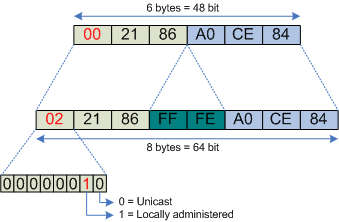Difference between revisions of "EUI-64"
m |
m (→Generating the Modified EUI-64) |
||
| (2 intermediate revisions by the same user not shown) | |||
| Line 1: | Line 1: | ||
| − | =EUI-64= | + | __NOTOC__ |
| − | EUI-64<ref>http://standards.ieee.org/develop/regauth/tut/eui64.pdf</ref> or Extended Unique Identifier is a 64 bit Global Identifier administered by IEEE<ref>http://www.ieee.org/index.html</ref> FireWire<ref>http://en.wikipedia.org/wiki/IEEE_1394_interface</ref> and in IPv6 as least significant 64 bits in [[Link-Local IPv6 Address|Link-Local]] and [[Global Unicast IPv6 Address|Global Unicast]] if [[Stateless Autoconfiguration IPv6|Stateless Autoconfiguration]]. (Except Systems that will choice a Random page fx. [[Windows 7 IPv6|Windows 7]]) | + | EUI-64 or Modified EUI-64 are often used as the lower 64 bit of a [[IPv6 Address]]. |
| − | =EUI-48= | + | ==EUI-64== |
| − | EUI-48<ref>http://standards.ieee.org/develop/regauth/tut/eui48.pdf</ref> or Extended Unique Identifier is a 48 bit Global Identifier administered by IEEE<ref>http://www.ieee.org/index.html</ref>. Ethernet MAC addresses is a example of EUI-48 usage. Other examples of technologies that use EUI-48 are [[Bluetooth]] and 802.11 Wireless Networks. | + | EUI-64<ref>http://standards.ieee.org/develop/regauth/tut/eui64.pdf</ref> or Extended Unique Identifier is a 64 bit Global Identifier administered by IEEE<ref name=IEEE>http://www.ieee.org/index.html</ref> |
| − | =References= | + | ===Examples of use=== |
| + | FireWire<ref>http://en.wikipedia.org/wiki/IEEE_1394_interface</ref> and in IPv6 as least significant 64 bits in [[Link-Local IPv6 Address|Link-Local]] and [[Global Unicast IPv6 Address|Global Unicast]] if [[Stateless Autoconfiguration IPv6|Stateless Autoconfiguration]]. (Except Systems that will choice a Random page fx. [[Windows 7 IPv6|Windows 7]]) | ||
| + | ==EUI-48== | ||
| + | EUI-48<ref>http://standards.ieee.org/develop/regauth/tut/eui48.pdf</ref> or Extended Unique Identifier is a 48 bit Global Identifier administered by IEEE<ref>http://www.ieee.org/index.html</ref>. | ||
| + | ===Examples of use=== | ||
| + | Ethernet MAC addresses is a example of EUI-48 usage. Other examples of technologies that use EUI-48 are [[Bluetooth]] and 802.11 Wireless Networks. | ||
| + | ==IPv6 Modifed EUI-64 Address== | ||
| + | {| | ||
| + | |valign="top" | | ||
| + | ===Understanding the MAC-Address=== | ||
| + | The MAC-Address is divided into two parts. | ||
| + | #The first 24 bits identifies the manufacturer and are called the OUI | ||
| + | ##The OUI is administered by IEEE<ref name=IEEE /> | ||
| + | #The last 24 bits identifies Extension Identifier or NIC | ||
| + | ##The manufacturer can use this field as serial-number | ||
| + | The MAC-Address is Global Unique and has two flag in its first octet. (Byte) | ||
| + | *bit 1: Unicast or Multicast | ||
| + | **The MAC 'broadcast' address FF:FF:FF:FF:FF:FF is really a Well-Known link-local Multicast address used by for example IPv4 ARP and DHCP. | ||
| + | *bit 2: Globally or locally administered. When bit 2 is 0 the Global Unique IEEE<ref name=IEEE /> identifier is used. When bit 2 is 1 it's a Local generated address. | ||
| + | |||
| + | | | ||
| + | [[Image:MAC address.png|400px|The MAC-address is a EUI-48 Identifier]] | ||
| + | |- | ||
| + | |valign="top" | | ||
| + | ==Generating the Modified EUI-64== | ||
| + | When generating a modified EUI-64 as the 64 lower bits of a [[IPv6 Address]] the hosts EUI-48 (MAC-Address) is expanded to 64 bits by inserting FF:FE between the OUI and the Extension Identifer or NIC and setting the Locally Administered Bit. | ||
| + | ===Example=== | ||
| + | *A node with MAC-address 00:10:56:A7:16:D5 will generate 00:10:56:'''FF:FE''':A7:16:D5 as EUI-64 | ||
| + | | | ||
| + | [[Image:EUI-64 address generation.png|400px|Generation of the EUI-64 identifier from the MAC-address]] | ||
| + | |- | ||
| + | |} | ||
| + | |||
| + | ==References== | ||
<references/> | <references/> | ||
[[Category:IPv6]] | [[Category:IPv6]] | ||
Latest revision as of 12:18, 13 June 2011
EUI-64 or Modified EUI-64 are often used as the lower 64 bit of a IPv6 Address.
EUI-64
EUI-64[1] or Extended Unique Identifier is a 64 bit Global Identifier administered by IEEE[2]
Examples of use
FireWire[3] and in IPv6 as least significant 64 bits in Link-Local and Global Unicast if Stateless Autoconfiguration. (Except Systems that will choice a Random page fx. Windows 7)
EUI-48
EUI-48[4] or Extended Unique Identifier is a 48 bit Global Identifier administered by IEEE[5].
Examples of use
Ethernet MAC addresses is a example of EUI-48 usage. Other examples of technologies that use EUI-48 are Bluetooth and 802.11 Wireless Networks.
IPv6 Modifed EUI-64 Address
Understanding the MAC-AddressThe MAC-Address is divided into two parts.
The MAC-Address is Global Unique and has two flag in its first octet. (Byte)
|
|
Generating the Modified EUI-64When generating a modified EUI-64 as the 64 lower bits of a IPv6 Address the hosts EUI-48 (MAC-Address) is expanded to 64 bits by inserting FF:FE between the OUI and the Extension Identifer or NIC and setting the Locally Administered Bit. Example
|

